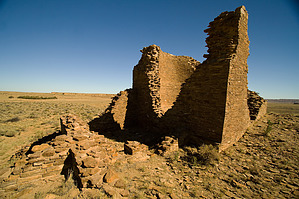| Guide | ♦ | 6 Triplogs | 3 Topics |
details | drive | permit | forecast | map |
stats |
photos | triplogs | topics | location |
| 43 | 6 | 3 |
Gambler Tales and the dark side of Black House by Randal_Schulhauser History (part 1): Kin Klizhin is a small Chacoan great house that lies about 7 miles south and west of the South Gap entrance to "downtown" Chaco Canyon connected by a major Chacoan Road. Tree-ring dates collected by Florence Hawley in 1932 indicate that a major construction period occurred about A.D. 1087. This indicates that this Chacoan tower kiva site pre-dates the other prominent tower kiva site, Kin Ya'a, by about 19 years. Great Houses are thought to be ceremonial centers utilized by many surrounding communities. The Kin Klizhin Wash shows evidence of earthen dams and primitive irrigation canals thought to sustain an agricultural community. The tower kiva is located in the central part of the building at the back west wall standing 4 stories tall. The 15 foot diameter circular kiva was surrounded within a solidly-filled, rectangular masonry enclosure, adding to the massiveness and stability of the tower. Today, the walls of the tower kiva stand 28 feet above the ground. The interior of the tower kiva may have contained 3 or 4 floors and had a very special ceremonial function (more on this later...). Four stacked kivas may have been symbolic of the 4 worlds central to Puebloan belief. Some researchers suggest that the towering structures may have been used for signaling to other communities. Less than a dozen tower kivas are known to exist in the Chacoan world, several of them located just south of the Chaco Canyon core. They occur late in Chacoan times. The great house is fronted on the east by a D-shaped plaza enclosed by a wall. Most of this wall is covered by wind-blown sand and reduced to fallen, scattered masonry. The plaza does not appear to contain any structures. Plazas are important areas at modern pueblos, where many activities take place; public ceremonies, trading, community gatherings, and daily activities. Aerial photographs reveal that a prehistoric roadway passes Kin Klizhin. This road originates in Chaco Canyon, heading south from South Gap (a natural break in the mesa). After leaving the gap, the road turns west and leads directly to Kin Klizhin. From Kin Klizhin the road continues due west to the Kin Bineola Valley and passes one mile north of Kin Bineola great house. Outliers share many of the typical Chacoan traits, such as architecture, masonry, roads, great kivas, enclosed plazas, pottery, etc. Some researchers believe the outliers were established by the people of Chaco Canyon as they expanded their world and influence into surrounding areas. Others believe that local populations embraced the Chacoan world and culture and emulated the great houses and their impressive architecture. The relationship between the outliers and the people of Chaco Canyon is not well understood. Were the outliers independent or did they support and serve the people in the core?
Hike: As you leave the Visitor Center at Chaco Culture National Historic Park, travel 3 miles south on Route 57 and then another 9 miles west on an unnamed double-track. The unnamed double-track passes south of South Mesa and West Mesa roughly paralleling an ancient Chacoan road. As you dip into Kin Klizhin Wash at about mile 12, you'll spot the ruins to the south on a rise within the flood plain. On the western side of the wash you will notice a fork in the double-track. Some Navajo ruins are located at the west fork. Take the south fork through some brush towards Kin Klizhin trail head. Sign the registry and complete a CCNHP trail pass and explore the Kin Klizhin ruins at your leisure. You are likely to have this site all to yourself (the last entry we saw in the registry was 10 days prior). You will likely be drawn to the spire of the tower kiva. Note the thickness of the masonry wall as it tapers towards the sky. Don't ignore the plaza ruins to the east of the main site. Sand has filled the walls and plaza leaving only some exposed rubble in segments. Although not as abundant as I expected, there's still many fine examples of Chacoan black and white pottery sherds to be examined here. Gaze to the east and also to the west and spot remnants of the earthen dams built by the Chacoans. The double-track continues west towards the Kin Bineola outlier ruins. About 2 miles east of Kin Klizhin we entered an area of sandy dunes - too much for my 2WD stock F-150 so we retrace our tracks back to Route 57. Summary: Kin Klizhin was my second experience exploring a Chacoan outlier. HAZ hike descriptions now exist for 3 additional Chacoan outliers - Kin Bineola, Pueblo Pintado, and Kin Ya'a. Go experience one for yourself! Enjoy! Chaco Canyon HP NPS Details NPS PDF Resource Check out the Triplogs. Leave No Trace and +Add a Triplog after your hike to support this local community. | |||||||||||||||||||||||||||||||||||||||||||||||||||||||||||||||||||||||||||||||||||||||||||||||||||||||||||||||||||||||||||||||||||||||||||||||||||||||||||||||
 Route Editor
Route Editor




